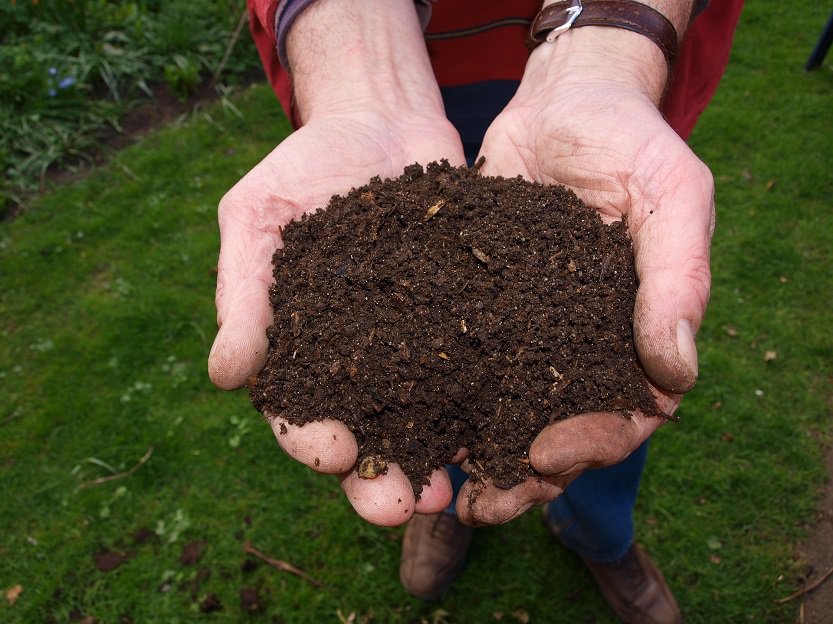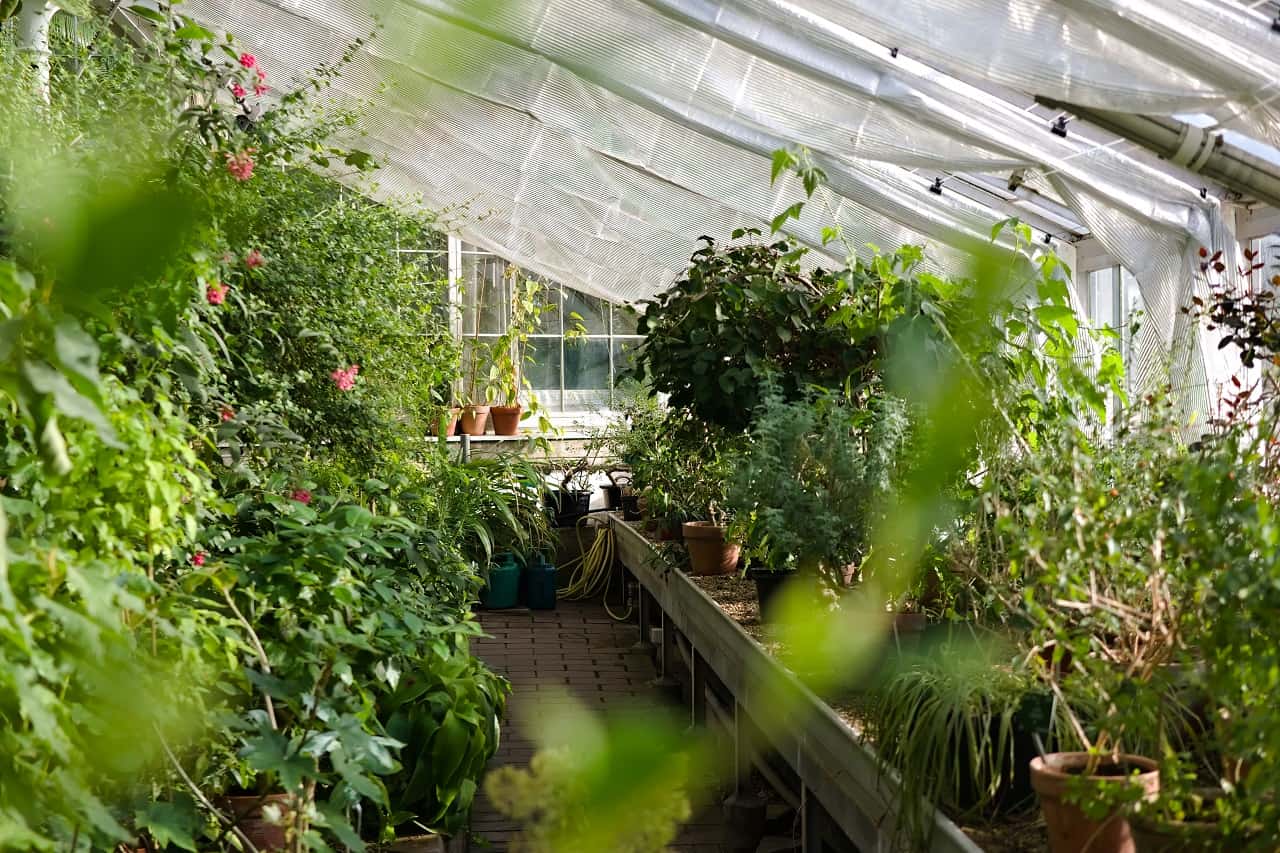If you want to know how to heat a greenhouse without electricity you’re in luck since there are plenty of options available.
Some of the methods we’ll go over in this article include heating a greenhouse with water barrels, heating with compost, heating a greenhouse with solar panels, and geothermal greenhouse heating,
And you might even be able to heat a greenhouse with candles if you live in an area with very mild winters.
If you’re interested in a good book that teaches you how to grow crops in a greenhouse all year long we recommend The Year-Round Solar Greenhouse: How to Design and Build a Net-Zero Energy Greenhouse (Buy Onlinie)
Heating a Greenhouse with Water Barrels
Water Barrels (Buy Online) are one of the cheapest and most efficient ways to store heat in a greenhouse. Water also has the highest heat storage capacity per volume of any commonly available material.
Black water barrels can absorb thermal energy during the day from the sun, or from the ambient heat in the greenhouse. When the temperature in the greenhouse drops below the temperature of the water it will re-radiate the heat back into the greenhouse. And this heat transfer will continue until the water and the greenhouse reach thermal equilibrium.
The best way to use water barrels in a greenhouse is to create a ‘water wall’ by stacking several large black drums filled with water on the north wall of a greenhouse. This will create a large thermal battery that will help stabilize the temperature along the whole length of the greenhouse.
The main disadvantage of using water barrels in a greenhouse is that they can take up a considerable amount of space, which otherwise could be used for plants.
Another disadvantage of using water barrels is that you can’t control their heat output. This is mainly due to the fact that they are dependent on the sun, and the ambient air temperature of the greenhouse. That means water barrels will store and release less energy during periods of cool cloudy weather.
Heating with Compost

Compost can be used as a sustainable source of heat in a greenhouse. Hot composting releases a considerable amount of heat as the microbes decompose the organic material in a large compost pile.
A compost pile can generate temperatures up to 160 F degrees under optimal conditions. That means if you locate a compost pile in your greenhouse, you can use the metabolic energy of the microbes to heat your greenhouse without using any electricity.
Compost Tumbler
You can use a Compost Tumbler (Buy Online) as an efficient heat source in your greenhouse. A compost tumbler makes rich compost quickly with minimal effort. It also won’t take up a lot of space, and it will release heat evenly across its entire surface.
Alternatively, you can dig a trench in your greenhouse, and create a large old fashioned compost pile to heat your greenhouse. If you want to go that route you can use the following instructions to help you build a compost pile in a greenhouse.
How to Heat a Greenhouse with Compost
Step 1
Dig a trench in your greenhouse that is at least 3-feet wide, 3-feet long, and 3-feet deep.
Step 2
Collect all the organic compost material that you plan to add to your compost pile.
Green compost materials include items like grass clippings, clover, moss, kitchen scraps, and manure.
Brown compost material include leaves, straw, wood chips, and cardboard
Step 3
Make sure all the compost materials are cut into small pieces. You can chop denser materials with shears, and you can use a lawnmower to mulch grass, leaves, and straw.
Step 4
Fill the hole you dug with alternating layers of green compost materials and brown compost materials.
Water the compost pile deeply until all the material is wet, but be careful not to over saturate the compost pile
Then you’ll need to throw some finished compost onto the pile to jump-start the composting process. You can also use a compost starter if you don’t have any readily available finished compost.
Step 5
You should check the temperature of the compost pile daily with an oven thermometer.
Once the pile reaches 120 F degrees the composting process will be in full swing. If the temperature drops below 120 F then you’ll want to turn the pile with a pitchfork to aerate the compost.
Step 6
When the compost pile finally cools down, and everything looks decomposed you can sift out any large pieces and save them for your next batch of compost.
Then you can use the finished compost in your garden or your greenhouse.
Rocket Mass Heaters
Rocket Mass Heaters (Buy Online) are an extremely efficient way to sustainably heat a greenhouse. Rocket Mass Heaters are simple to operate, and in some areas, it might cost next to nothing to fuel them.
A rocket mass heater is more efficient than a regular wood burner since it recycles its exhaust to enhance the combustion process. That also makes it cleaner to run since the main components of the exhaust are CO2, steam, and a little bit of smoke from the unburnt carbon.
Due to the efficient design of a Rocket Mass Heater, they are capable of heating a greenhouse using up to 90% less wood than a stove or heater.
Rocket mass heaters also take advantage of the thermal storage capacity of the soil to retain heat over long periods. The exhaust pipe of a rocket mass stove can even be buried under the garden beds in a greenhouse to deliver heat right to the roots of the plants.
Overall, rocket mass heaters are a great way to heat a greenhouse without electricity, especially if you live in a highly wooded area. In that case, your fuel will most likely be free, and you won’t have to rely on the sun or any other complicated technologies to keep your greenhouse frost-free all winter.
How To Heat a Greenhouse with Solar Panels
Evacuated Solar Tubes (Buy Online) are another great way to heat a greenhouse without electricity. This type of solar system doesn’t produce electricity like a solar photovoltaic panel, instead, it efficiently captures the heat from the sun using vacuum-sealed radiator fins.
Solar thermal panels utilize antifreeze that moves through sealed radiators in a closed-loop system to transfer the heat into a large insulated hot water storage container.
The hot water can then be routed through pipes in a greenhouse to release the heat into the air, or it can be connected to an underground heating system.
You can also use an evacuated solar thermal system to boost the efficiency of solar water barrels. The water in the barrels, in that case, won’t be as well insulated, but you’ll be able to store more heat than you could with passive heat absorption using black water barrels.
Heat Greenhouse with Candles
You might be able to heat your greenhouse with candles if you live in an area with mild winters. Candles aren’t the best greenhouse heating option, but they can be used to keep the air around your plants warm enough to prevent mild frost damage.
Just be aware that a 13-gram paraffin wax candle will only produce about 30-watts of heat per hour. This isn’t a lot of heat and you would need about 3 candles to equal the amount of heat generated by a 100-watt heater.
Candles will lose their heat to the air very quickly, which can further reduce their overall efficiency. If you want to retain the thermal energy emitted by a candle you can use clay pots to trap and concentrate the heat for a longer period. The clay pot will act as a thermal mass and absorb the heat, and then it will slowly radiate the heat back into the greenhouse near your plants where the heat is needed.
How To Heat Greenhouse Without Electricity
Geothermal Greenhouse Heating
The earth beneath your feet contains a vast untapped pool of free thermal energy. All you need to do is find a way to capture that energy and transfer it into your greenhouse to keep your plants warm all winter.
Geothermal Greenhouse Heating Systems
Geothermal heating systems are classified into three main categories (low, medium, and high temperature). The most common types of geothermal systems used in greenhouses tend to fall in the low to medium energy category.
Air geothermal systems and fluid-based geothermal systems transfer lower temperature heat from the ground below the frost line and concentrate it to raise the ambient temperature in a greenhouse.
These types of geothermal systems tend to be an economical way to heat a greenhouse since they pay for themselves in about ten years depending on the cost of electricity or fuel in your area.
In the following sections we’ll go into more detail about the types of geothermal heating systems you can use to heat a greenhouse:
Air Systems
Air Based Systems are the most affordable and simplest geothermal heating systems that you can install in a greenhouse. These geothermal systems gather heat by passing air through long corrugated plastic tubes that are buried deep in the earth below the frost line.
The air is then warmed by the surrounding soil as it passes through the tubes, and then it is released directly into the greenhouse. This type of system will also work in reverse in the summer to keep a greenhouse cool by transferring excess heat into the cooler sub-soil.
A geothermal air system still relies on a small amount of electricity to power the fans that move the air through the tubes. But this electricity can be supplied by a small solar panel connected to a battery pack that will let it run at night when the added heat will be most needed.
Unassisted geothermal air systems will only be able to output air that’s the same temperature as the soil. The average soil temperature 8-feet below the surface can range from 40 F in late winter to 65 F in late fall. That means an unassisted geothermal air system will protect your plants from freezing, but you can’t expect it to dramatically raise the air temperature in a greenhouse.
To increase the temperature above that of the ambient soil temperature you need to use an air-to-air heat pump. A heat pump works like a reversible air conditioner, and it can raise the temperature in a greenhouse to 80 F to 90 F.
Keep in mind, a heat pump will consume a good amount of electricity, and they are more efficient when used with a fluid-based system, which we’ll go over in more detail in the next section.
Fluid systems
Liquid geothermal systems typically transfer heat from the soil, well, pond, or any other thermally stable body of water.
Fluid Based Geothermal systems primarily extract heat from their surroundings using water, propylene glycol or methyl alcohol in either a closed-loop or open-loop system. This relatively low-temperature fluid is then delivered to a heat pump where the energy is extracted and concentrated.
Closed-loop systems
A closed-loop geothermal system circulates an antifreeze solution through narrow pipes that are buried deep underground. In the winter the antifreeze absorbs the heat from the surrounding soil and carries it above ground to a heat exchanger.
Fluid based geothermal systems are more efficient than air systems since most liquids have a higher thermal conductivity, which allows them to transfer heat more efficiently.
Liquid also has a higher heat storage capacity than air, so you can use narrower underground pipes compared to an air-based geothermal system.
Open-loop systems
Open-loop systems take advantage of groundwater from a well, or they can even use a large body of water. In an open-loop system, water is pumped up from one well, and then it is returned to a second well. This will keep the water temperature stable in the first well as long as the wells are far enough apart.
The other way to configure an open-loop geothermal system is to pump the water out of a large pond or a lake. Then you’ll need to return the water far enough away from the intake so you don’t recirculate the cold water back into your greenhouse.
Open-loop systems can be very efficient and cheap to operate if you have a large property with multiple wells, or if you have a large pond that doesn’t freeze over completely in the winter. However, open-loop systems can be challenging to manage, and you need to be careful not to pollute your water source.
Insulation
There are some things that you need to make sure you do before you get any type of heating system. First, you want to properly insulate the greenhouse, and reduce the amount of air that leaks into your greenhouse.
These steps will reduce heat loss considerably and it will reduce the overall size of the heating system you’ll need to use in your greenhouse.











